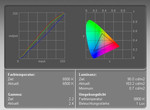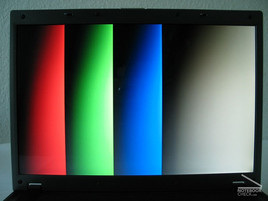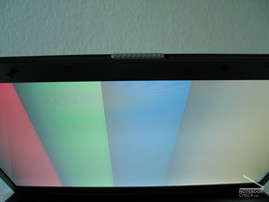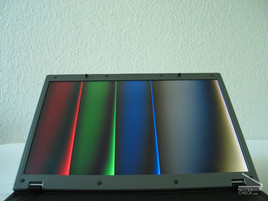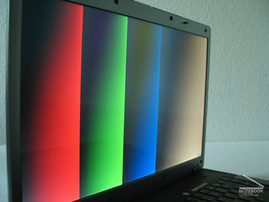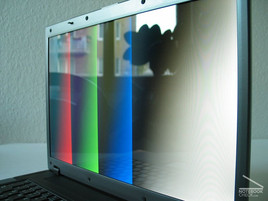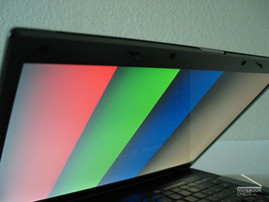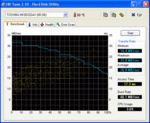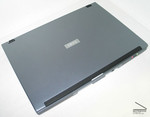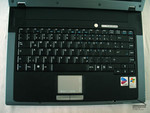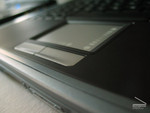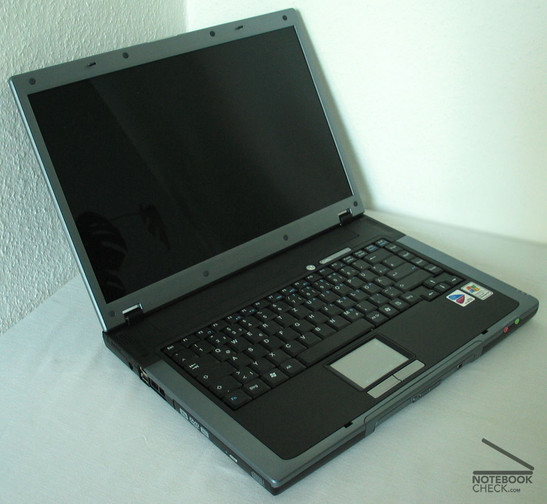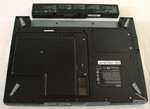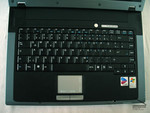Duration Time of the Accumulator
In the Classic test (3D animation with all settings and brightness on maximum, WLAN on) of the accu-testprogramm BatteryEater the Accu held out in the test for accurately 1 hour and 47 minutes - an average value.
In the reader test (settings on minimum, WLAN out) the laptop had a lack of energy after 3 hours 46 minutes.
The measured current consumption was:
Idle 27 - 31 Watt
Idle + WLAN: 28 - 33 Watt
Full load: 64 - 67 Watt
Volume
In a closed room without other acoustic sources a quiet noise can be noticed from inside of the case.
The quiet but continuously running ventilator sounds without load with bearable 37.3 dB. With hard disk accesses the volume rises to 38,2 dB.
We noticed a quiet but unpleasant sound of high frequency, caused by our test model (the volume without load increases to 38dB) when using the Touchpad. However the phenomenon did not arise everytime.
With full load we measured the following volumes:
ventilator level 2: 39,4 dB (immediately switches itself on with increased load)
ventilator level 3: 41,6 dB (after a few minutes load)
ventilator level 4: 43,3 dB (again after approximately 10 minutes later in the test)
2 small loudspeakers are behind the keyboard, which supply a quality quite good regarding their size.
Display
The gap between case and cover evenly sizes to 2-3 mm (a few laptops had a gap on one side which were nearly twice as large as on the other side...). The display bolting device functions without troubles. During repeated closing and opening no crunching noises can be heared. This also significates a workmanship of high quality. The hinges are symmetrically, in each case on the outer side of the hinge there is a pin as suspension, while inside cables run. The stable hinges do not sway. The display can be bent averagely.
Once again there is a shining, but at the same time also reflecting display. Meanwhile reflecting displays become a standard, although an important disadvantage is obvious. All the same whether sun, fluorescent tube or simply sharply contrasted shade. Everything is reflected in the shining displays.
View from extreme viewing angles: vertically there occur like with most laptops a few color distortions, while the horizontal view presents a very stable image. Regarding the image quality the MSI M645 can be compared with display favorites like the Sony Vaio VGN-FS215M, Sony Vaio PCG K315Z, Sony Vaio VGN A417M and Asus Z9252V.
The image regeneration rate is very good, too.
The illumination of the test equipment is at a low level of 75%.
Performance
The following bench mark values show a performance, which can be expected from this performance class (upper middle class). All current games can be played with medium settings. The current consumption is good compared with the performance. Compared with the M635 the power ratings are very similar (except Doom3, where Nvidia grafic cards got an advantage).
3DMark01
15436 points
3DMark03
5528 points
3DMark05
2344 points
Doom 3
low: 89,9 fps
medium: 89,9 fps
high: 61,6 fps
high (1024x768): 56,6 fps
ultra: 56,6 fps
Quake 3 Arena
Timedemo result: 279,1 fps
PCMark04
3840 points
Here the Centrino based M645 shows advantages with the file compression, audio transformation and grafics memory compared with the M635
HDTune
Transfer rate: min 16,4 MB/s, 31,8 MB/s, 26 MB/s
Access Time: 17,3 ms
Burst Rate: 66,1 MB/s
CPU load: 3,6%
Result
The MSI M645 makes a good impression according various aspacts. The workmanship leaves hardly any chance for criticism and the display also is of outstanding quality. The most severe problem is the position of the ventilator opening.
The performance and the duration time of the Accumulator are slightly better in relation to the "sister"-model M635.
Accessories
The power pack is 13x6x3cm small and weights 550 g. So it is quite easy portable.
The M645 has a status light on the plug, which is attached to the laptop.
Emissions
Unfortunately here a severe problem rises: the blow-out opening of the ventilation system is in the front range of the right narrow side! As well known the large majority of the users are right-handers and most of them use a mouse. In cold winter at fresh air one may be glad, when the hand is warmed permanently but otherwise...
The ventilator openings are small and rectangular and the air enters the laptop at the bottom. The disadvantage is that when the laptop is positioned on soft surface the air supply can be interrupted. Regrettably meanwhile the majority of the laptops has openings at the bottom.
The temperature of the keyboard surface is comfortable low, which ensures a pleasant working with the keyboard. The bottom of the case heats up more than the upper surface, but compared with other notebooks the temperature is tolerable and does not exclude a usage on the thighs.
Under load the maximum temperature rises to 42°C on the top side over the ventilator exit. The average temperature remains acceptable with 32°C. The lower surface reaches a maximum of 40°C and an average value of 33°C.
Input Devices
The keyboard torches with strong pressing the keys, but the extent of this effect does not really obstruct the usage. The pressing-noise is pleasant and accompanied by quiet clicking noises. The size of the keyboard is average (30 x 11cm) just like the key size and the distance of the keys from each other. That is not natural with all laptops. The keys are stable and do not tremble.
There does not exist a particular numeric block, like usually. The arrow keys and page scroll keys are smaller than the remaining keys. The arrow keys are separated from the remaining keyboard block, which is very comfortable for players, who often need these keys. The separation avoids wrong clicks. The enter key is unfortunately somewhat small and is encicled all around by other keys. Here wrong clicks are probable. The FN-key is at the outside left edge of the keyboard. Some notebooks got there the STR-key. Unfortunately it is not sure, what the standard is.
The keyboard does not imprint on the cover, even if someone presses on the closed cover.
The Touchpad is transferred slightly to the left in front of the keyboard. So it may happen that someone sends touchpad signals inadvertently with the thumb when working or playing with the keyboard. By the way, the finger interface is not rectangular but rhombic and corresponds approximately the quantity to 7x4cm. There are 2 touchpad keys under the finger surface medium size, which can be click at the edge too. There is no scroll button. The two keys do not tremble and the operability of the Touchpads seems normally.
Case
The two-colored case just like the similar MSI M635 has black areas but is dominated by dark grey metallic (e.g. cover). The bright silver metallic parts do not exist.
The magnesium alloy makes the laptop light and durable. E.G. no scratches occured when we tried to scratch on the surface with metal.
Towards the edges the slim case is very rigid and stable, in the center torches massively. However that might not impair the stability altogether.
If the M645 is rised with one hand at the edge or if one tries to bend it with both hands, the laptop does not bend or crunch. A laptop, which does not create any crunches in the material tests was rather rare with the past tests (in the short test column only the cases of the Toshiba Satellite A80 - 142 and Sony Vaio VGN-FS215M are of similar workmanship quality).
The gap dimensions of the case are even and usually under 1mm, which further indicates that the equipment is of good quality. Nevertheless, at the edge of the keyboard, there is, like so often, a deep groove between work surface and keyboard. Here dirt can accumulate and perhaps penetrate inside the equipment.
There are no sharp edges anywhere, not even at the borders of the opening for the accumulator.
Nearly all connections are on the left and right narrow side, but regrettably none on the back, where connections would disturb hardly any user.
There exist 4 USB connections, which is a generous amount. Some laptops only provide 2 USB Slots. Cables, which are attached to the USBs on the right side, can obstruct right-handers using a mouse. USB cables connected at the left side can disturb left-handed people. As long as someone does not need more than 2 connections, he may connect at the other side in each case. Nevertheless shifting the connections to the rear would have been perfect.
There is a Firewire connection on the front narrow side.
All connections are situated very near together, often only with 1 mm distance. so the plugs can obstruct each other. This concerns particularly the USB-connections which are positioned above another.
The ejection mechanism of the PC-cardreaders functions without problems. There exists a ST-MMC-cardreader too. The DVD drive assembly opens and closes whithout jams.
The accumulator with the size 27 x 4,5 x 2 can be attached and removed without jamming and the bolting device functions without problems. The accu is stuck on on the rear narrow side and forms the back of the laptop.
On the front narrow side there is a sliding control with the label "volume" and a button with a note. The button starts the Windows Media Player. However the "Vol" slide control does not change the volume of the Media Players. We failed to discover any function of the sliding control.
The MSI M645 stands on its rubber feet on smooth surface stably without to slip much.





